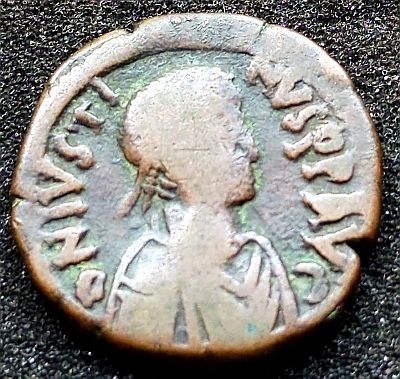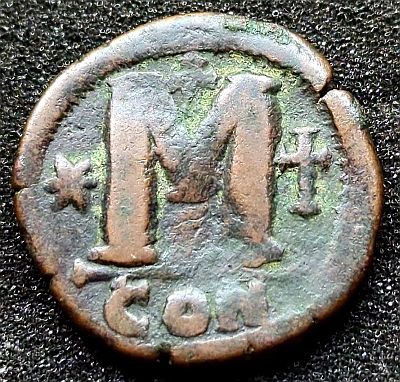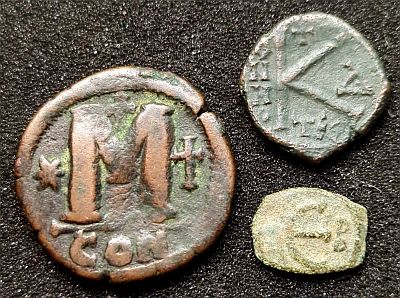A nice large early Byzantine coin
Obverse

This coin was issued under Justin I, emperor of the Eastern Roman, or Byzantine Empire from 518 – 527 A.D. I have previously shared not only a Byzantine coin, but a 5 Nummi coin issued under Justin I. So let’s look at some different aspects of this one.
While the obverse is broadly very similar to the other coin I have shared previously, one point worth noting is the inscription. The inscription is quite clear and easy to read: DNIVSTI NVSPAVG. The translation of this, from Numista is:
D(-ominus) N(-oster) IVSTINVS P(-er-)P(-etuus) AVG(-vstvs)
“Our Lord Justin, Perpetual Emperor”
Many Byzantine coins have a variation of DN (name) PP AVG. There were several Justins and Justinians so the inscription can sometimes be quite similar.
Reverse

The exact start date of the Byzantine empire is debatable (313A.D., 330A.D., 395A.D., etc). There is, however, a fairly distinct line in terms of bronze coinage. Byzantine emperor Anastasius (491-518 AD) introduced a new coinage. This reform of 498 A.D. ended the production of tiny scraps of metal and focused on the “Follis”, a large bronze coin worth 40 of the old, tiny coins. Although the Byzantines thought of themselves as “Roman”, they drifted further and further apart. Rather than Latin, Greek was predominent in the Eastern Roman empire, and this brings us back to our coin.
The reverse of the coin features a star, the letter “M” and a cross. Underneath, are the letters CON, short for Constantinople. This was the name of the capital of the Eastern Roman Empire. Originally a small Greek settlement founded by a ruler called Byzas. Byzantium grew into a major port city. When Constantine I defeated Licinius to become sole emperor in 324 A.D., he established a new capital at Byzantium called “Nova Roma” or New Rome. While the city has had many names, it endured as the Byzantine capital for more than 1,100 years. These days, you might know it as “Istanbul“, the capital of Turkey. Another interesting feature of the city is that is spread onto two continents, Europe and Asia. I must admit knowing that Istanbul was previously Constantinople is something I originally learnt from a song by They Might Be Giants. And if you can’t remember how to spell the old name, I found a song for that too – C-O-N-S-T-A-N-T-I-N-O-P-L-E, from 1928 (released just two years before it officially changed to Istanbul).
The reverse of the coin is dominated by a large letter “M”. This represents the number 40 in Greek, as this coin was worth 40 of the old smaller “Nummi” coins. Other coins introduced in the reformation were the half-follis, worth 20 Nummi, denoted by a large “K”, and “ϵ” for 5 Nummi. There were also “I” (10 Nummi) and other values issued at different times.

Image of three Byzantine coins showing the different sizes and values. Not all coins followed this pattern exactly. The 5 Nummi coin I’ve previously posted has a Chi Rho symbol as its prominent reverse feature. That coin does also have the ϵ to denote the value.
In some cases, such as the half follis above, the value to the right, is “∆”, Delta, an officina mark denoting the 4th officina, or the 4th year of reign in that case. Collecting lettered Byzantine bronze coins is a fun, and often inexpensive area of numismatics. AugustusCoins have an excellent and extensive resource on Byzantine coins. ForumAncientCoins also has a guide to lettered Byzantine coins.


Leave a Reply